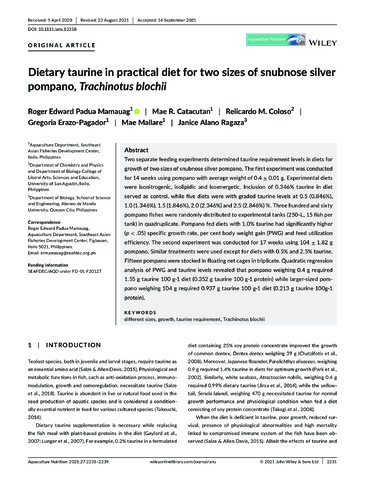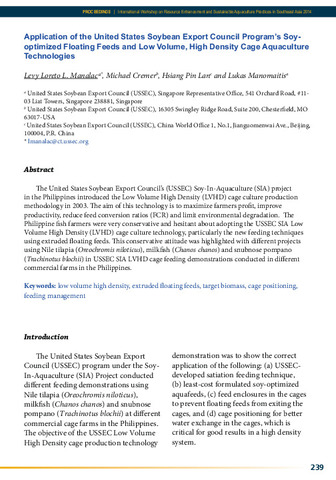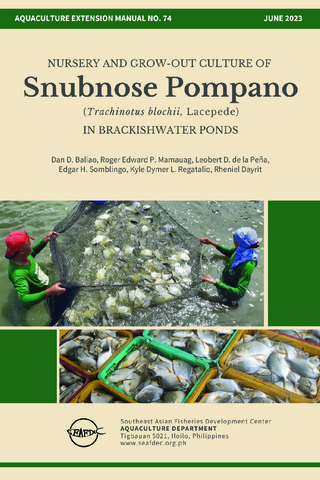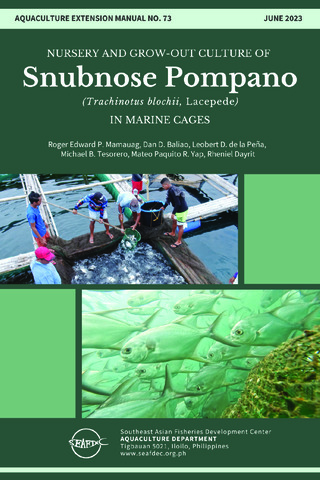Dietary taurine in practical diet for two sizes of snubnose silver pompano, Trachinotus blochii

View/Open
Date
2021-09-27Author
Page views
502Metadata
Show full item recordCited times in Scopus
1
CITATION
1
Total citation
0
Recent citations
0.31
Field Citation Ratio
n/a
Relative Citation Ratio
- Citations
- Scopus - Citation Indexes: 1
- Captures
- Mendeley - Readers: 5
Share
Abstract
Two separate feeding experiments determined taurine requirement levels in diets for growth of two sizes of snubnose silver pompano. The first experiment was conducted for 14 weeks using pompano with average weight of 0.4 ± 0.01 g. Experimental diets were isonitrogenic, isolipidic and isoenergetic. Inclusion of 0.346% taurine in diet served as control, while five diets were with graded taurine levels at 0.5 (0.846%), 1.0 (1.346%), 1.5 (1.846%), 2.0 (2.346%) and 2.5 (2.846%) %. Three hundred and sixty pompano fishes were randomly distributed to experimental tanks (250-L, 15 fish per tank) in quadruplicate. Pompano fed diets with 1.0% taurine had significantly higher (p < .05) specific growth rate, per cent body weight gain (PWG) and feed utilization efficiency. The second experiment was conducted for 17 weeks using 104 ± 1.82 g pompano. Similar treatments were used except for diets with 0.5% and 2.5% taurine. Fifteen pompano were stocked in floating net cages in triplicate. Quadratic regression analysis of PWG and taurine levels revealed that pompano weighing 0.4 g required 1.55 g taurine 100 g-1 diet (0.352 g taurine 100 g-1 protein) while larger-sized pompano weighing 104 g required 0.937 g taurine 100 g-1 diet (0.213 g taurine 100g-1 protein).
Suggested Citation
Mamauag, R. E., Catacutan, M. R., Coloso, R. M., Erazo-Pagador, G., Mallare, M. F., & Ragaza, J. (2021). Dietary taurine in practical diet for two sizes of snubnose silver pompano, Trachinotus blochii. Aquaculture Nutrition , 27(6), 2231-2239. https://doi.org/10.1111/anu.13358
Subject
growth  ; size
; size  ; amino acids
; amino acids  ; fish
; fish  ; diet
; diet  ; feed composition
; feed composition  ; feeds
; feeds  ; feeding experiments
; feeding experiments  ; Trachinotus blochii
; Trachinotus blochii  ; pompanos
; pompanos 
 ; size
; size  ; amino acids
; amino acids  ; fish
; fish  ; diet
; diet  ; feed composition
; feed composition  ; feeds
; feeds  ; feeding experiments
; feeding experiments  ; Trachinotus blochii
; Trachinotus blochii  ; pompanos
; pompanos 
Collections
- AQD Journal Articles [1248]
Related items
Showing items related by title, author, creator and subject.
-
Application of the United States Soybean Export Council program's soy-optimized floating feeds and low volume, high density cage aquaculture technologies
Manalac, Levy Loreto L.; Cremer, Michael; Lan, Hsiang Pin (Aquaculture Department, Southeast Asian Fisheries Development Center, 2015)The United States Soybean Export Council s (USSEC) Soy-In-Aquaculture (SIA) project in the Philippines introduced the Low Volume High Density (LVHD) cage culture production methodology in 2003. The aim of this technology ... -
Nursery and grow-out culture of snubnose pompano (Trachinotus blochii, Lacepede) in brackishwater ponds
Baliao, Dan D.; Mamauag, Roger Edward; de la Peña, Leobert D.; Somblingo, Edgar H.; Regatalio, Kyle Dymer L.; Dayrit, Rheniel (2023-06)This manual, titled “Nursery and Grow-out Culture of Snubnose Pompano (Trachinotus blochii, Lacepede) in Brackishwater Ponds,” includes culture techniques and good practices developed through extensive research done at the ... -
Nursery and grow-out culture of snubnose pompano (Trachinotus blochii, Lacepede) in marine cages
Mamauag, Roger Edward; Baliao, Dan D.; de la Peña, Leobert D.; Tesorero, Michael B.; Yap, Mateo Paquito R.; Dayrit, Rheniel (2023-06)This manual, titled “Nursery and Grow-out Culture of Snubnose Pompano (Trachinotus blochii, Lacepede) in Marine Cages,” includes culture methods and good practices that are the product of research done at the Aquaculture ...




